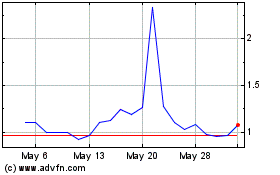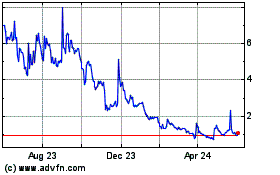June 24, 2024
Biodexa Pharmaceuticals PLC
Biodexa Announces Positive Phase 2
Clinical Trial Results of eRapa™ at 12 months in Familial
Adenomatous Polyposis (FAP)
Overall 75% Non-progression Rate at 12
Months
Median Decrease in Overall Polyp Burden
at 12 Months of 17%
Cohort 2 Non-progression Rate at 12
months of 81% and Median Decrease in Poly Burden of 29% Informs
Phase 3 Dosage Regimen
Data Reported in Oral Presentation at
2024 Bi-Annual InSIGHT Meeting
(DATELINE) JUNE 24 -- Biodexa
Pharmaceuticals PLC (“Biodexa” or the “Company”) (Nasdaq: BDRX), an
acquisition-focused clinical stage biopharmaceutical company
developing a pipeline of innovative products for the treatment of
diseases with unmet medical needs, announced that 12 month results
of a Phase 2 clinical trial of eRapa™ in Familial Adenomatous
Polyposis (“FAP”) (NCT04230499) were reported in an oral
presentation at the prestigious 2024 InSIGHT bi-annual meeting in
Barcelona by Carol Burke, M.D., a specialist gastroenterologist at
the Cleveland Clinic and a leading authority in FAP, a mostly
genetic disease of precancerous polyps for which the only current
remedy is surgical removal of the colon and/or rectum.
The Phase 2 study was partially supported by $3
million in grant funding from the Cancer Prevention and Research
Institute of Texas (CPRIT) under product development awards DP22053
and DP190069. The Phase 3 study of eRapa in FAP is
supported by a $17 million grant from CPRIT. Dr. Burke is the
Principal Investigator for the both the Phase 2 study and the
upcoming Phase 3 registrational study.
Stephen Stamp, CEO of Biodexa, said, “The
promising Phase 2 results, if confirmed in a registrational Phase 3
study, may delay or potentially obviate the need for resection of
the colon and/or rectum in FAP patients. The six-month, and now
12-month, data together with its apparent tolerability suggest
longer term use of eRapa may be possible, with the potential to
forestall resection and substantially increase the quality of life
of patients with this devastating pre-cancerous condition impacting
up to 40,000 patients in the U.S. and up to 60,000 in Europe.”
Design of the Phase 2 studyThe
open-label study was conducted in seven U.S. centers of excellence
in 30 adult patients with median age of 43 years with intact colon
(n=6) or post-colectomy and ileo-rectal anastomosis and at least 10
adenomas in the rectal remanent (n=24).
Patients were sequentially enrolled into three
dosing cohorts of 10 patients each for a 12-month treatment period:
0.5mg every other day (Cohort 1), 0.5mg daily every other week
(Cohort 2), and 0.5mg daily (Cohort 3). Upper and lower endoscopic
surveillance occurred at baseline and after six months. Although
the primary endpoints were safety and tolerability of eRapa and
percentage change from baseline in polyp burden at six months, as
measured by the aggregate of all polyp diameters, patients
continued to receive treatment and monitoring for 12 months
(secondary endpoint).
Results of the Phase 2 study at 12
monthsOverall, 21 of 28 (75%) patients were deemed to be
non-progressors at 12 months with a median reduction in polyp
burden of 17%.
In Cohort 2, eight of nine (89)% of patients
were deemed non-progressors at 12 months with a median reduction in
polyp burden of 29%.
Over the course of 12 months, there were four
related Grade 3 or higher and one related Serious Adverse Event
reported during the trial and 95% compliance rate at 12 months. One
patient was removed from the trial due to non-compliance.
In summary, eRapa appeared safe and
well-tolerated with a median 17% reduction in the total polyp
burden at 12 months compared with baseline and an overall 75%
non-progression rate. The 89% non-progression rate and 29% median
reduction in polyp burden in Cohort 2 is likely to be the preferred
dosage regimen for Phase 3.
Polyp burden data at six months compared with
baseline was presented at the Digestive Disease Weekly scientific
conference in Washinton D.C. on May 21, 2024.
Planned Phase 3 registrational study of
eRapa in FAPThe Phase 3 registrational study is planned to
be a double-blind placebo-controlled design recruiting
approximately 140 high risk patients diagnosed with germline or
phenotypic FAP. The primary clinical endpoint is likely to be the
first progression free survival event which will include major
surgery (or referral thereto), polypectomy for advanced neoplasia,
advancement of Spigelman stage, diagnosis of high-grade dysplasia
or cancer and death from any cause. A $17 million grant from CPRIT
will support this study.
About eRapaeRapa is a
proprietary oral tablet formulation of rapamycin, also known as
sirolimus. Rapamycin is an mTOR (mammalian Target Of Rapamycin)
inhibitor. mTOR has been shown to have a significant role in the
signalling pathway that regulates cellular metabolism, growth and
proliferation and is activated during tumorgenesis1. Rapamycin is
approved in the US for organ rejection in renal transplantation as
Rapamune®(Pfizer). Through the use of nanotechnology and pH
sensitive polymers, eRapa is designed to address the poor
bioavailability, variable pharmacokinetics and toxicity generally
associated with the currently available forms of rapamycin. eRapa
is protected by a number of issued patents which extend through
2035, with other pending applications potentially providing further
protection beyond 2035.
eRapa in FAPFAP is
characterized as a proliferation of polyps in the colon and/or
rectum, usually occurring in mid-teens. There is no approved
therapeutic option for treating FAP patients, for whom active
surveillance and surgical resection of the colon and/or rectum
remain the standard of care. If untreated, FAP typically leads to
cancer of the colon and/or rectum. There is a significant
hereditary component to FAP with a reported incidence of one in
5,000 to 10,000 in the US2 and one in 11,300 to 37,600 in Europe3.
eRapa has received Orphan Designation in the US with plans to seek
such designation in Europe. Importantly, mTOR has been shown to be
over-expressed in FAP polyps – thereby underscoring the rationale
for using a potent and safe mTOR inhibitor like eRapa to treat
FAP.
About the Cancer Prevention and Research
Institute of TexasCPRIT was created by the Texas
Legislature and approved by a statewide vote in 2007 to lead the
Lone Star State’s fight against cancer. In 2019, Texas voters again
voted overwhelmingly to continue CPRIT with an additional $3
billion for a total $6 billion investment in cancer research and
prevention. To date, CPRIT has awarded over $3 billion in grants to
Texas research institutions and organizations through its academic
research, prevention and product development research programs.
CPRIT has also recruited more than 281 distinguished researchers to
Texas, supported the establishment, expansion or relocation of 51
companies to Texas and generated over $7.66 billion in additional
public and private investment. CPRIT funding has advanced
scientific and clinical knowledge and provided over 8.1 million
life-saving cancer prevention and early detection services to
Texans in all 254 counties. Learn more
at https://cprit.texas.gov.
1. Tian et al., mTOR
Signalling in Cancer and mTOR Inhibitors in Solid Tumor Targeting
Therapy, Int J Mol Sci. 2019 Feb; 20(3):
7552. www.rarediseases.org3. www.orpha.net
For more information, please contact:
|
Biodexa Pharmaceuticals PLC |
|
Stephen Stamp, CEO, CFOTel: +44 (0)29 20480
180www.biodexapharma.com |
About Biodexa Pharmaceuticals PLC
Biodexa Pharmaceuticals PLC (listed on NASDAQ:
BDRX) is a clinical stage biopharmaceutical company developing a
pipeline of innovative products for the treatment of diseases with
unmet medical needs. The Company’s lead development programs
include eRapa, under development for Familial Adenomatous Polyposis
and Non-Muscle Invasive Blader Cancer: tolimidone, under
development as a for the treatment of type 1 diabetes; and MTX110,
which is being studied in aggressive rare/orphan brain cancer
indications.
eRapa is a proprietary oral tablet formulation
of rapamycin, also known as sirolimus. Rapamycin is an mTOR
(mammalian Target Of Rapamycin) inhibitor. mTOR has been shown to
have a significant role in the signalling pathway that regulates
cellular metabolism, growth and proliferation and is activated
during tumorgenesis.
Tolimidone is an orally delivered, potent and
selective inhibitor of Lyn kinase. Lyn is a member of the Src
family of protein tyrosine kinases, which is mainly expressed in
hematopoietic cells, in neural tissues, liver, and adipose tissue.
Tolimidone demonstrates glycemic control via insulin sensitization
in animal models of diabetes and has the potential to become a
first in class blood glucose modulating agent.
MTX110 is a solubilised formulation of the
histone deacetylase (HDAC) inhibitor, panobinostat. This
proprietary formulation enables delivery of the product via
convection-enhanced delivery (CED) at chemotherapeutic doses
directly to the site of the tumor, by-passing the blood-brain
barrier and potentially avoiding systemic toxicity.
Biodexa is supported by three proprietary drug
delivery technologies focused on improving the bio-delivery and
bio-distribution of medicines. Biodexa’s headquarters and R&D
facility is in Cardiff, UK. For more information visit
www.biodexapharma.com.
Forward-Looking
Statements
Certain statements in this announcement may
constitute “forward-looking statements” within the meaning of
legislation in the United Kingdom and/or United States. Such
statements are made pursuant to the safe harbor provisions of the
Private Securities Litigation Reform Act of 1995 and are based on
management’s belief or interpretation. All statements contained in
this announcement that do not relate to matters of historical fact
should be considered forward-looking statements. In certain cases,
forward-looking statements can be identified by the use of words
such as “plans”, “expects” or “does not anticipate”, or “believes”,
or variations of such words and phrases or statements that certain
actions, events or results “may”, “could”, “would”, “might” or
“will be taken”, “occur” or “be achieved.” Forward-looking
statements and information are subject to various known and unknown
risks and uncertainties, many of which are beyond the ability of
the Company to control or predict, that may cause their actual
results, performance or achievements to be materially different
from those expressed or implied thereby, and are developed based on
assumptions about such risks, uncertainties and other factors set
out herein.
Reference should be made to those documents that
Biodexa shall file from time to time or announcements that may be
made by Biodexa in accordance with the rules and regulations
promulgated by the SEC, which contain and identify other important
factors that could cause actual results to differ materially from
those contained in any projections or forward-looking statements.
These forward-looking statements speak only as of the date of this
announcement. All subsequent written and oral forward-looking
statements by or concerning Biodexa are expressly qualified in
their entirety by the cautionary statements above. Except as may be
required under relevant laws in the United States, Biodexa does not
undertake any obligation to publicly update or revise any
forward-looking statements because of new information, future
events or events otherwise arising.
Biodexa Pharmaceuticals (NASDAQ:BDRX)
Historical Stock Chart
From Dec 2024 to Jan 2025

Biodexa Pharmaceuticals (NASDAQ:BDRX)
Historical Stock Chart
From Jan 2024 to Jan 2025
